| [1] 吴昊,石展英,李百川,等.不同内固定方式对后踝骨折固定的生物力学效果及临床疗效分析[J].现代生物医学进展,2013,13(26): 5094-5098.
[2] Clyde J, Kosmopoulos V, Carpenter B, et al. A biomechanical investigation of a knotless tension band in medial malleolar fracture models in composite sawbones? J Foot Ankle Surg. 2013;52(2):192-194.
[3] Harper MC, Hardin G. Posterior malleolar fractures of the ankle associated with external rotation-abduction injuries. Results with and without internal fixation. J Bone Joint Surg Am. 1988;70(9):1348-1356.
[4] 刁振斌,夏元升,赵静华,等.经外踝钢板双螺钉交接棒技术内固定治疗下胫腓联合损伤[J].中国骨与关节损伤杂志,2014,29(6): 562-564.
[5] 顾鸿程,蒋兴良,徐兵,等.1/3管形钢板结合拉力螺钉治疗踝关节骨折[J].长春中医药大学学报,2008,24(4):410-411.
[6] 黄雄飞.应用AO钢板加螺钉内固定治疗BC型踝关节骨折[J].中国药物与临床,2004,4(9):680-681.
[7] 彭松明,何晓斌,刘克斌,等.后外侧入路手术治疗三踝关节骨折[J].中国骨与关节损伤杂志,2014,29(6):621-622.
[8] 李健伟,佘黎平,周世梅,等.3D打印技术在踝关节骨折手术中的应用[J].中国骨科临床与基础研究杂志,2014,6(6):333-338.
[9] 樊健,俞光荣,周家钤,等.后外侧入路在老年性踝关节骨折中的应用[J].中国矫形外科杂志,2012,20(10):865-867.
[10] Barnett PLJ, Lee MH, Oh L, et al. Functional outcome after air-stirrup ankle brace or fiberglass backslab for pediatric low-risk ankle fractures: a randomized observer-blinded controlled trial. Pediatric Emergency Care. 2012;28(8):745-749.
[11] 陆桂成.胫骨远端锁定钢板对Pilon骨折治疗的作用与探讨[J].中国医药指南,2015,13(20):121-122.
[12] 刘建华,余世明,徐栋梁,等.切开复位内固定治疗踝关节骨折的临床研究[J].中国基层医药,2013,20(17):2584-2586.
[13] Pakarinen H, Ohtonen P, Lakovaara M, et al. Intraoperative assessment of the stability of the distal tibiofibular joint in supination-external rotation injuries of the ankle: sensitivity, specificity, and reliability of two clinical tests. J Bone Joint Surg Am. 2011;93/A(22):2057-2061.
[14] Franzone JM, Vosseller JT. Posterolateral approach for open reduction and internal fixation of a posterior malleolus fracture-Hinging on an intact PITFL to disimpact the tibial plafond: a technical note. Foot Ankle Int. 2013;34(8):1177-1181.
[15] Nabees,姜保国,张殿英,等.普通钢板与点状接触钛金属板内固定固定后板下组织学改变的对比观察[J].中国临床康复,2002, 6(12): 1738-1739.
[16] 李海平,刘观燚,徐荣明,等.后外侧入路空心钉内固定治疗下胫腓后韧带止点撕脱后踝骨折[J].中国骨与关节损伤杂志,2013, 28(10): 984-985.
[17] Utsugi K, Sakai H, Hiraoka H, et al. Intra-articular fibrous tissue formation following ankle fracture: the significance of arthroscopic debridement of fibrous tissue. Arthroscopy. 2007; 23(1):89-93.
[18] Donken CC, Goorden AJ, Verhofstad MH, et al. The outcome at 20 years of conservatively treated 'isolated' posterior malleolar fractures of the ankle: a case series. J Bone Joint Surg. 2011;93/B(12):1621-1625.
[19] 巴吾东买合苏木.腓骨解剖型钢板拉力螺钉治疗踝关节骨折45例的临床分析[J].中国医学创新,2011,8(24):136-137.
[20] 秦冠军,林昂如,裴国献,等.踝关节骨折脱位中下胫腓联合分离的诊断与治疗[J].中华创伤骨科杂志,2006,8(5):481-482.
[21] 贾瑞钢,王俊飞,杨永江,等.Endobutton钢板和螺钉内固定治疗急性下胫腓联合损伤的比较研究[J].中国骨与关节损伤杂志, 2013, 28(6):586-587.
[22] 赵春海.钢板螺钉治疗踝关节骨折临床应用及疗效分析[J].当代医学,2012,18(11):113-126.
[23] 林镇荣,吴盛荣,苏剑,等.合并下胫腓联合分离的踝关节骨折脱位的诊断与治疗[J].河北医学,2007,13(5):553-555.
[24] Shibuya N, Frost CH, Campbell JD, et al. Incidence of acute deep vein thrombosis and pulmonary embolism in foot and ankle trauma: analysis of the national trauma data bank. J Foot Ankle Surg. 2012;51(1):63-68.
[25] 李健民.不同手术方法治疗不稳定性踝关节骨折的效果观察[J].医药前沿,2013,(23):110-111.
[26] Curry EE, O'Brien TS, Johnson JE, et al. Fibular nonunion and equinovarus deformity secondary to posterior tibial tendon incarceration in the syndesmosis: a case report after a bimalleolar fracture-dislocation. Foot Ankle Int. 1999;20(8): 527-531.
[27] Gehr J, Neber W, Hilsenbeck F, et al. New concepts in the treatment of ankle joint fractures. The IP-XS (XSL) and IP-XXS (XXSL) nail in the treatment of ankle joint fractures. Arch Orthop Trauma Surg. 2004;124(2):96-103.
[28] 朱春桥,许硕贵,吴亚乐,等.后侧腓骨钢板内固定在踝关节骨折中的应用[J].中国骨伤,2008,21(9):669-671.
[29] 王万秀,陈国林,杨延涛,等.解剖钢板、拉力螺钉治疗旋后外旋Ⅳ型踝关节骨折的临床体会[J].吉林医学,2010,31(15):2289.
[30] 白洪涛,常利民,贾卫斗,等.空心螺钉经前踝内固定治疗后踝关节骨折57例临床分析[J].中国煤炭工业医学杂志,2014,(9):1397-1399.
[31] 毛玉发,黄东海.踝关节骨折并下胫腓关节分离的手术内固定方案分析[J].临床合理用药杂志,2012,5(25):107-108.
[32] 辛景义,刘忠玉,严成渊,等.踝关节骨折合并Tillaux-Chaput和Volkmann骨折的临床特点及治疗方法[J].中华骨科杂志, 2013, 33(4):398-402.
[33] 李永耀,关继超,金阳,等.手术修补旋前外旋型Ⅲ度踝关节骨折三角韧带损伤的临床对照研究[J].中国中西医结合外科杂志, 2015, (3):293-295.
[34] 许玮,张旭鸣,施爱平,等.后外侧入路治疗合并后踝骨折的外旋型踝关节骨折33例[J].福建医药杂志,2014,(5):42-44.
[35] 李杨,王树森,杨宁,等.复杂踝关节骨折中后踝骨折及下胫腓联合分离的手术治疗体会[J].中国骨与关节损伤杂志,2014,29(12): 1289-1290. |
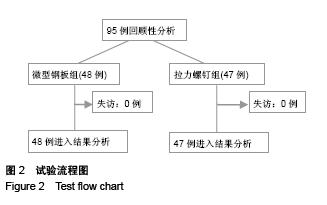
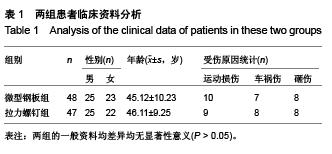
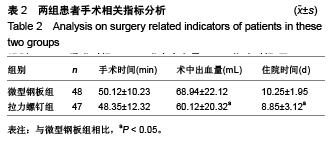
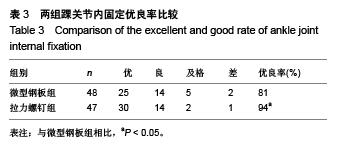
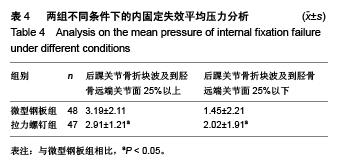
.jpg)